Basic Pigeon Color Genetics Especially For Rollers
By: Touhoua Yang
I have made this as basic as possible so it can be understood by nearly everyone and I have discarded a lot of scientific verbiage to make the overall message easily understood.
When I say single dose, that means the bird is heterozygous for a gene. When I say double dose, I mean the bird is homozygous for the gene.
Colors and Dominance:
There are only 3 true colors in pigeons. These three colors are the “base” color of all pigeons. Anything else is just a variation of these colors and every pigeon is really just one of these three colors but with modifiers. The three colors, in order of dominance, are:
1. Ash Red
2. Blue/Black
3. Brown.
So Ash Red is most dominant, then Blue and then Brown is least dominant.
A cockbird always has two colors but only the dominant color shows. For example, a cockbird could be ash red and ash red which means it is ash red and only ash red. It is not carrying a less dominant color. Or a cock bird could be blue and blue. If a cock bird has two colors, only the dominant color is usually seen.
Therefore a cock bird can also be ash red and blue. Since ash red is higher in the order of dominance, it will visually be an ash red bird but will carry blue. You can see the blue in the tail of these ash red cockbirds but only if the tail is not white. A blue cock bird cannot carry ash red since ash red is higher in the order of dominance but a blue cock bird can carry brown. A brown cockbird cannot carry any other color since brown is the least dominant color.
Hens only have 1 color and can never carry a second color. Therefore a hen can only be ash red, or blue, or brown. A hen’s color is what you see, it cannot hide or carry any other color.
Due to order of dominance, the baby cannot have a color that is in higher order of dominance than either parent. So two blue birds cannot produce an ash red baby. Two ash reds can produce a blue or a brown but the blue or brown will always be a hen.
Regardless of what the pigeon looks like on the outside, it always contains one or more of the three colors listed.
Patterns and Dominance
There are only 4 patterns that a pigeon can be and they are, in order of dominance:
1. T-check/velvet
2. Check
3. Bar
4. Barless
All pigeons, cocks and hens, can have two patterns. So unlike colors, hens also have two patterns. Much like color, if a pigeon has two different patterns, the more dominant pattern is visible while the less dominant pattern is usually hidden but may also “leak” through.
So a cock or a hen can be a check and a bar. The bird will show as a check but often times, you can also see the bar. Therefore the pigeon can pass the check or bar pattern onto its offspring. In order for the offspring to be a bar, it must receive two bar patterns, one from each parent. If an offspring receives the check pattern from its mom and a bar pattern from its father, it will be a check carrying bar. Just like color, a bar pigeon cannot carry check or t-check. A bar pigeon can only carry barless.
Due to order of dominance, the baby cannot have a pattern that is in higher order of dominance than either parent. For example, two bars cannot produce a check. Two checks cannot produce a T-check. However, two T-checks can produce T-checks, checks, and bars. Two checks can only produce checks and bars. Two bars can only produce bars (barless is almost non-existent in rollers)
Regardless of what the pigeon looks like on the outside, it always has two of the patterns listed above.
Common Color “Modifiers”
Here are a lists of different genes that modify the appearance of the color and/or pattern. Just remember, while these modifiers may change the overall appearance and color and pattern of the pigeon, the pigeon still has to be one of the colors and patterns listed above.
I will also include pictures of an ash red and a blue roller or pigeon with the modifier. I will include two names, the first is the common name we all call it by, the phenotype, and the second will be the name that gives its genetic color, or the genotype, which will be in parenthesis.
A. Dilute: Dilute is a gene that cuts the intensity of the base color in half, basically. The dilute of blue/black is silver and the dilute of ash red is ash yellow (simply yellow by most roller men). So the dilute gene on an ash red pigeon gives you yellow and the dilute gene on a blue pigeon gives you silver. Much like color, cocks can have two doses of dilute or one dose of dilute. Hens can only have one dose of dilute so a hen is either a dilute or isn’t a dilute. Because of this, it is known as a recessive sex-linked gene.
Recessive sex-linked genes basically means it is recessive to the dominant color (ash red, blue/black, and brown) and it’s carried on the sex chromosome. So if a cock bird has one dose of dilute, it will appear as a normal colored pigeon but carries dilute and can pass it down to its offspring, in particular, the hens. A hen cannot carry dilute so it’s either dilute or not. It does not need two doses of dilute to be dilute. A cock bird needs two doses of dilute to be dilute so in order for a cock to be dilute, it’s father and mother must both be dilute (father can carry dilute as long as the mother is dilute). Most who have dilute won’t know it until they have a yellow pop up since they cannot recognize a silver bar (dilute blue bar).
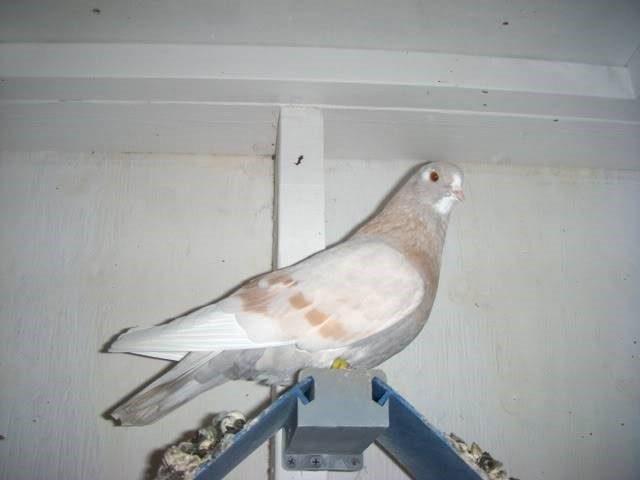
(Dilute Ash Red Bar)
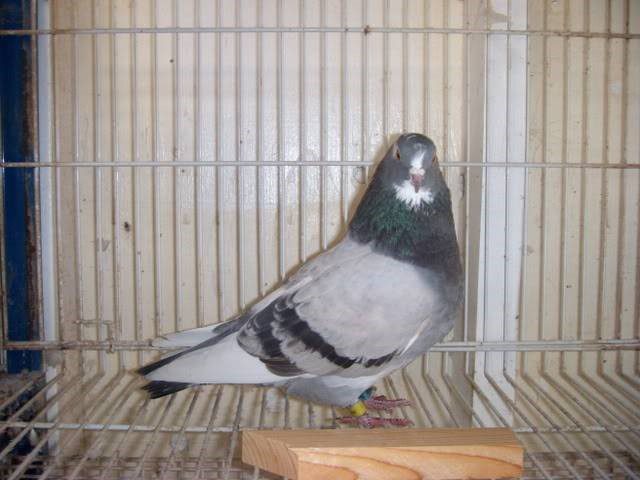
(Dilute Blue Bar)
B. Grizzle: Grizzle is a incomplete dominant modifier that adds flecking of white (or rather depigments the pigeon). Sometimes the grizzle affects just the head but most times, the grizzle will affect the entire pigeon’s body. Gives it the salt and pepper look. Much like patterns, all cocks and hens can have one dose of grizzle or two dozes of grizzle. Since grizzle is dominant, you only need one dose or gene of grizzle for a pigeon to be grizzle. But notice how grizzle is stated as a co-dominant modifier? Dominant means you only need a single dose and the incomplete dominance means that the expression changes when you have single dose or double dose of grizzle. If a pigeon has two doses of grizzle, there will be far more white than the actual base color. A double grizzle blue pigeon will be more white than blue and often times, it’s an almost white pigeon with flecks of blue/black and usually you can see the tips of the wings and tails being blue/black. We call this stork marked. A double grizzle ash red pigeon will be a near white pigeon with little flecks of red in the neck and body. Often times, a double grizzle ash red pigeon will be almost all white and the only tell are tiny tiny flecks of red.
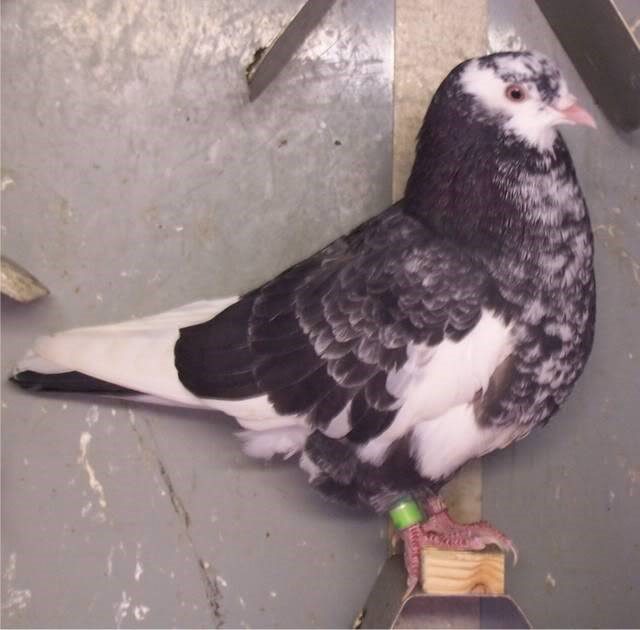
(Blue check hetro/single dose grizzle)
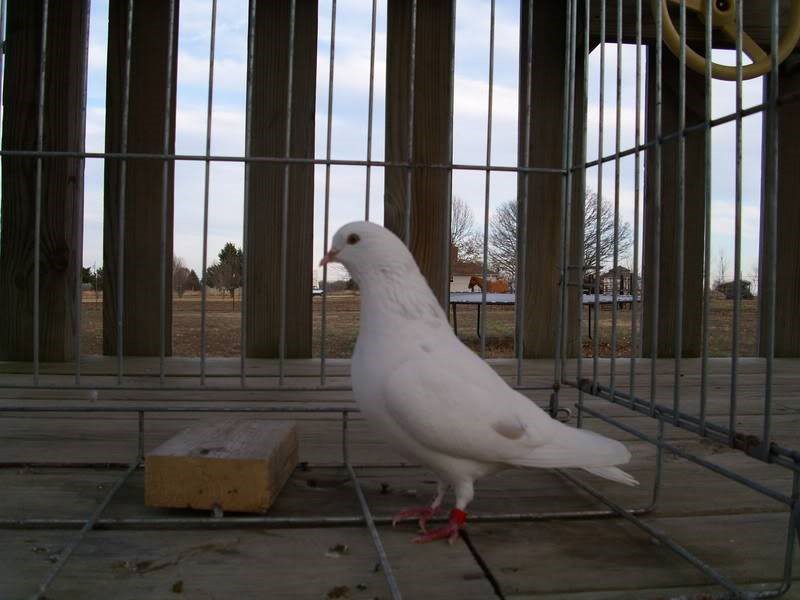
(Ash Red homozygous/double dose grizzle)
C. Spread: Spread is a dominant modifier that basically spreads the color of the tail band onto the entire pigeon. It is similar to patterns and the grizzle gene. Any pigeon can have two doses for spread but a single dose of spread be enough for the pigeon to be spread. A blue pigeon with the spread gene makes it a black pigeon and spread usually covers the pattern. For example, a blue check pgeon with the spread gene is a black pigeon. A blue bar pigeon with the spread gene is also a black pigeon. Sometimes you might be able to see the bars on a black pigeon, that means the pigeon is actually a blue bar but just has the spread gene covering the pigeon in the black color.
Spread on an ash red pigeon (red check or red bar), the pigeon is a lavender, which looks like a ashy-dull silver color. Much like a black pigeon, you can often see the bars and if you have an ash red pigeon carrying blue and it is also spread, you will see black flecking on the actual body of the pigeon instead of just the tail.
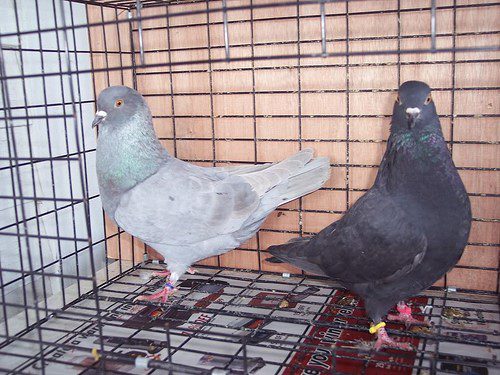
(Ash Red Spread Carrying Blue and a Blue Spread)
D. Recessive Red: Recessive red is a recessive modifier that causes a pigeon to appear to be a brick red color, sometimes it is a brighter or slightly duller brick red. Any pigeon can carry recessive red but it must have two doses to be recessive red since the modifier is recessive. Recessive red covers the entire pigeon in this singular color and much like black, it covers the pattern as well but remember that recessive red is not an actual color. Think of it like a sweater; underneath the sweater, the person can be wearing any color shirt with any pattern. So a recessive red pigeon is actually a blue bar, blue check, ash red bar, ash red check etc. It is very difficult to figure out if the recessive red pigeon is actually a blue base or red base pigeon without breeding it. So a blue recessive red and an ash red recessive red look identical.
Recessive reds usually are all recessive red color with all recessive red flights and tails or they are usually all recessive red in the head and body but the flights and tails will be all white or a mixture of white and recessive red.
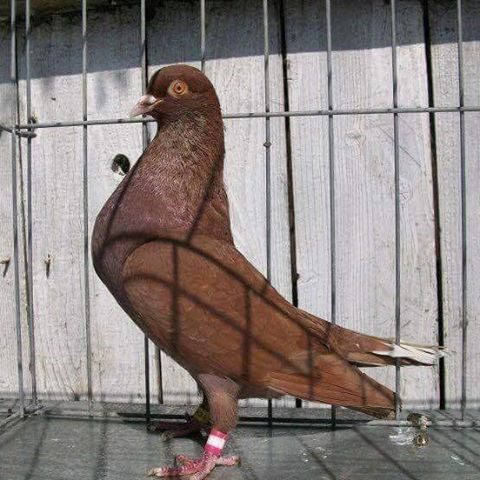
E. Recessive Yellow: Recessive yellow is the other yellow and is fairly common too. It’s exactly like recessive red except it is recessive red with the dilute gene, so it cuts the intensity of the recessive red in half which makes it an ashy yellow gene. A recessive yellow will not have a pattern present just like recessive red.
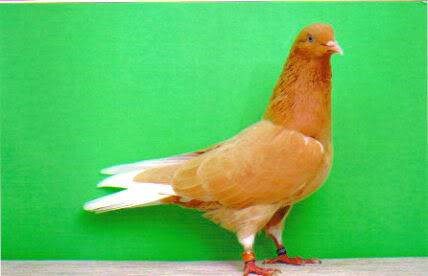
F. Indigo: Indigo is an incomplete dominant modifier that is best on a blue pigeon, it gives it the true indigo blue hue. Much like RR, Spread, Grizzle, and the patterns, any pigeon can have it in a single does or a double dose. But since it is a dominant modifier, you only need a single dose to see the indigo gene expressed. A single dose of indigo tends to give the better expression and since it is an incomplete dominance modifier, like grizzle, when you have it in two doses, it changes the way the pigeon looks. Double dose Indigo on a blue bar or check (indigo bar/check) often changes the bars into a reddish color and mimics ash red very well.
On an ash red pigeon, indigo is very hard to detect.
When you have a black pigeon (blue spread) and you add the indigo gene, you get an andalusian pigeon.
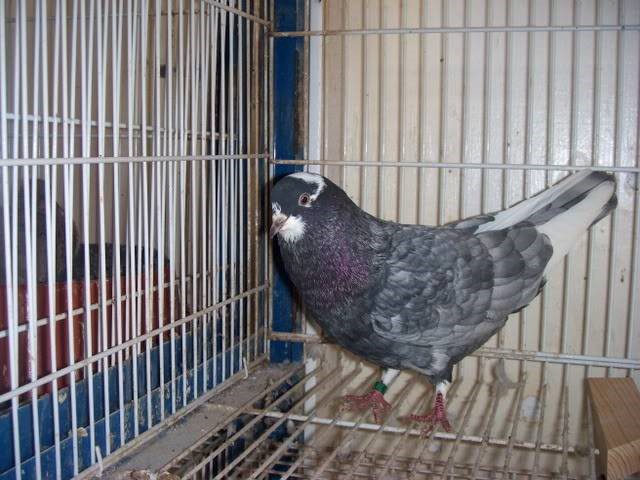
(Blue Spread hetero/single dose indigo)
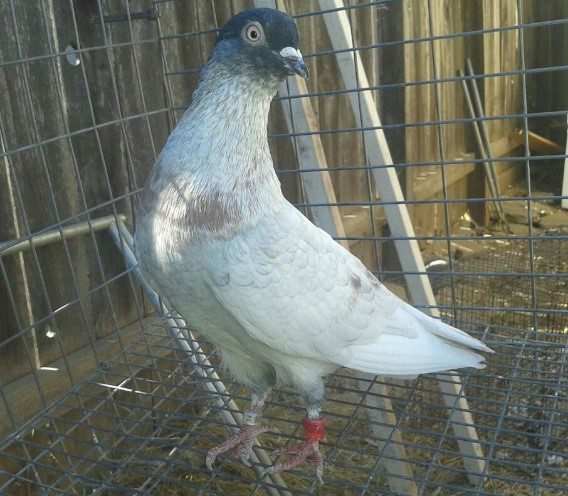
(Blue spread homo/double dose indigo)

(Homo/double dose indigo on a blue t-check)
G. Reduced: Reduced is a recessive sex-linked modifier that reduces or lessens the intensity of the color. Because it is a recessive sex-linked modifier, that means a hen cannot carry reduced; a hen is either a reduced or it isn’t. Being recessive, that means a cock bird must have two doses of the reduced gene to be reduced. If it only has one dose for reduced, it will look like a normal pigeon but half of its daughters will be reduced.
Reduced on a black pigeon (blue spread) will give you what is known as blue lace. It makes the black pigeon a light whitish/gray pigeon with lacing. Reduced, if in the right combinations, can give you a white bar, similar to opal. With reduced, it usually takes about 2 moults before the bird shows its true and final colors.
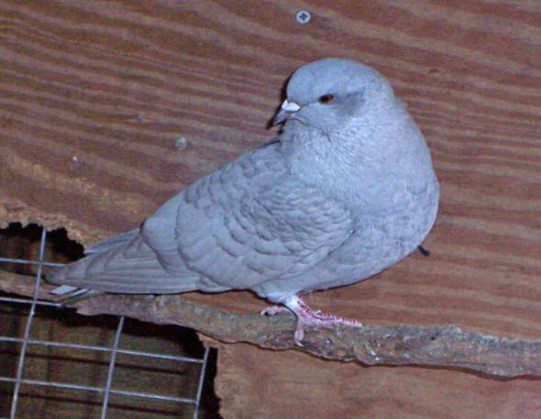
(Reduced spread blue)
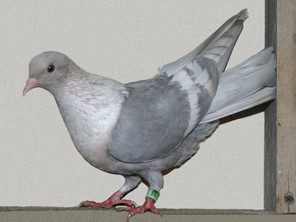
(reduced blue bar)
Sex-Linked Matings:
A sex-linked mating basically means when you can tell what the sex/gender of the babies will be based on the colors/modifers the baby inherited from the parents. Below of some basic sex-linked matings we see in rollers:
1. Blue cock (bar, check, spread) x Ash red hen (bar, check, spread) = all blue babies are hens and all ash
red babies are cocks (they will also carry blue)
2. Dilute cock x non-dilute hen = non-dilute cocks carrying
dilute and dilute hens.
–
Cocks carrying dilute x non-dilute hen = non-dilute cocks and 50% of hens will
be dilute
3. Reduced cock x non-reduced hen = non-reduced cock carrying reduced and reduced hens
4. Non-almond cock x almond hen = Almond cocks and non-almond hens f

